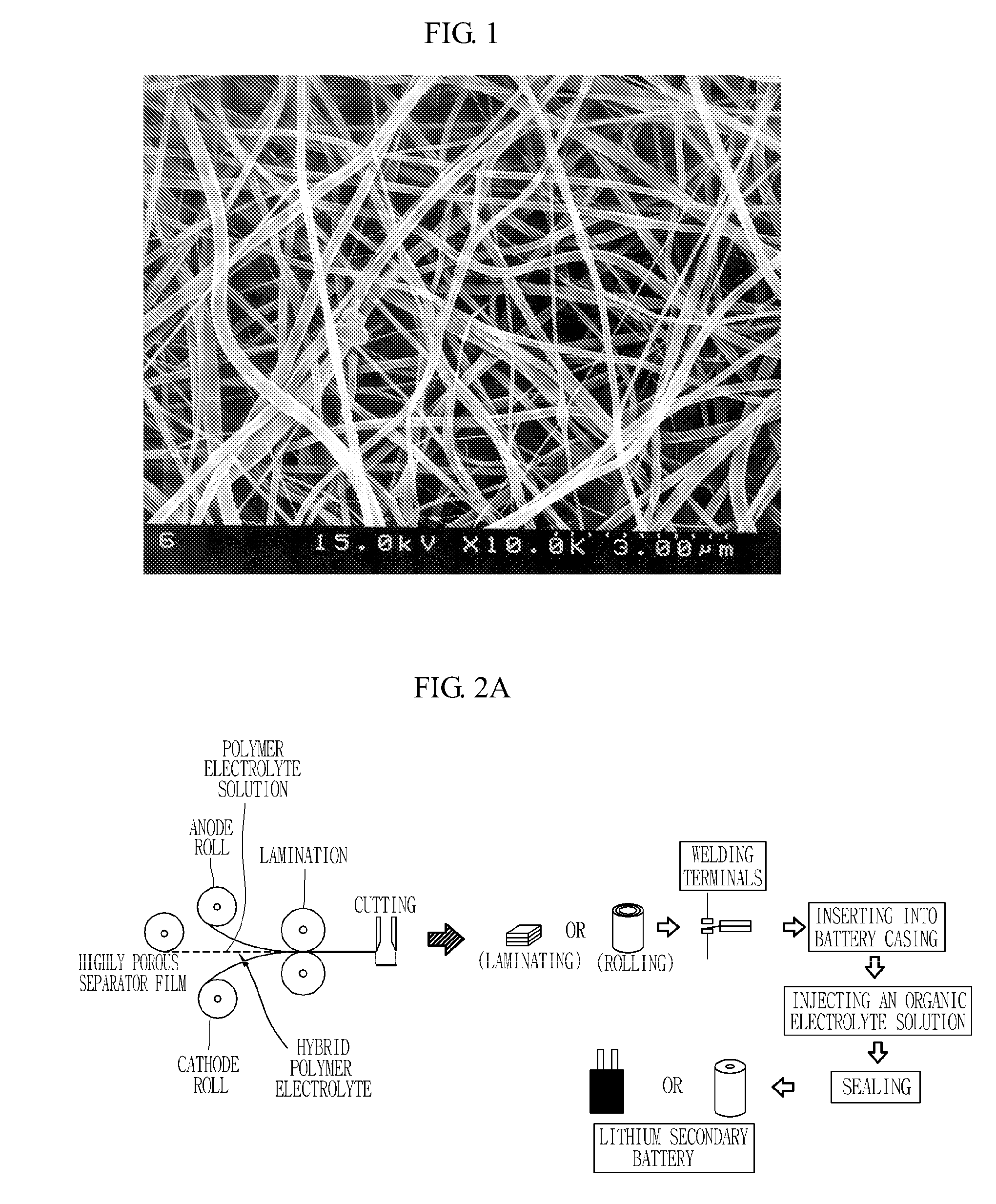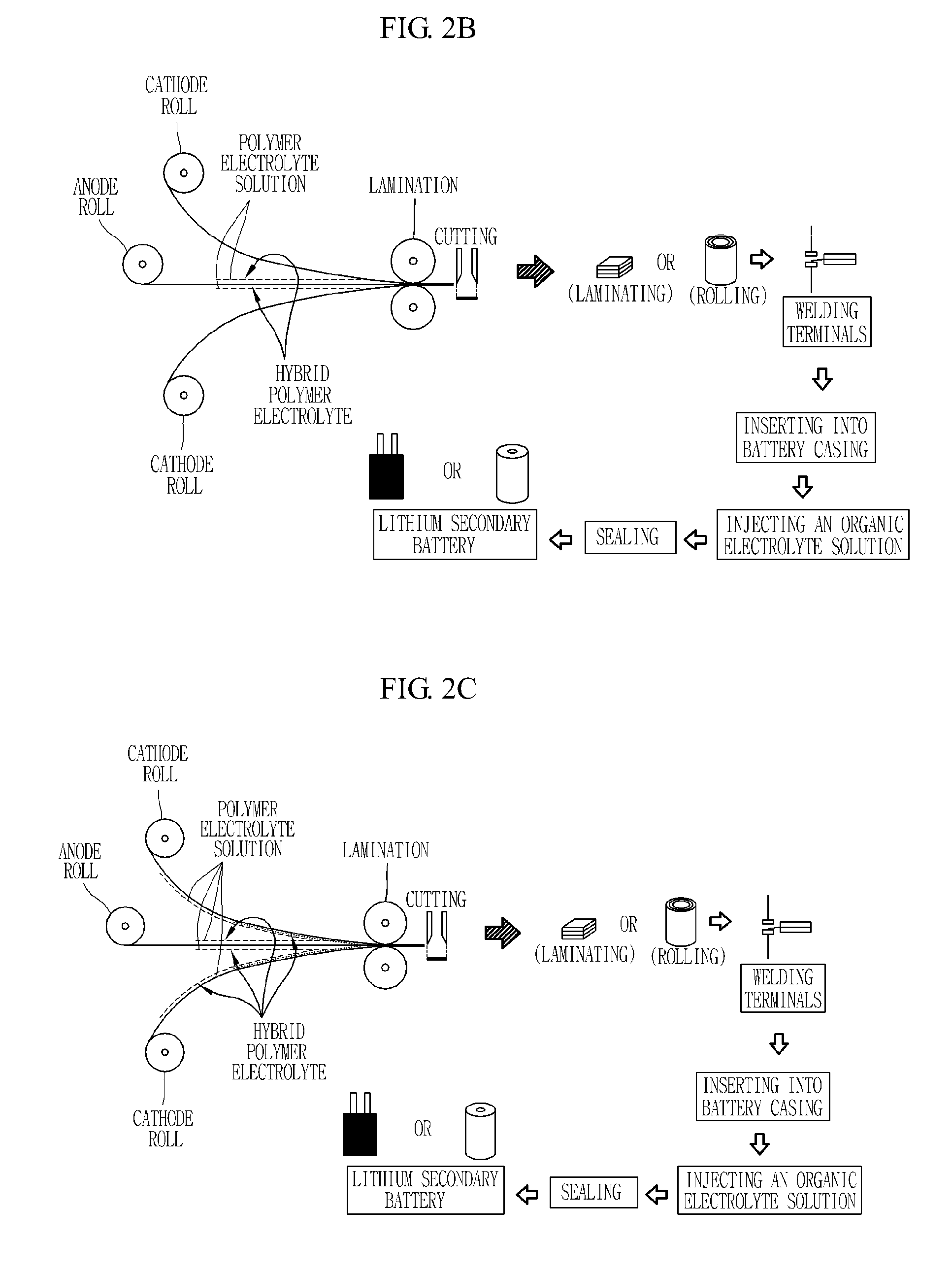Hybrid polymer electrolyte, a lithium secondary battery comprising the hybrid polymer electrolyte and their fabrication methods
a polymer electrolyte and hybrid technology, applied in the direction of wound/folded electrode electrodes, cell components, non-metal conductors, etc., can solve the problems of battery instability, inconvenient fabrication process, restriction of battery shape, etc., to achieve good mechanical strength, good low- and high-temperature characteristics, good adhesion with electrodes
- Summary
- Abstract
- Description
- Claims
- Application Information
AI Technical Summary
Benefits of technology
Problems solved by technology
Method used
Image
Examples
example 1
[0037]1-1) Fabrication of a Porous Polymer Matrix
[0038]20 g of polyvinylidenefluoride (Kynar 761) was added to 100 g of dimethylacetamide, and the resulting mixture was stirred at room temperature for 24 hours to give a clear polymeric solution. The resulting polymeric solution was filled into the barrel of an electrospinning apparatus and discharged onto a metal plate at a constant rate using a nozzle charged with 9 kV, to fabricate a porous polymer matrix film having a thickness of 50 μm.
[0039]1-2) Fabrication of a Hybrid Polymer Electrolyte
[0040]0.5 g of PAN (prepared by Polyscience Company, molecular weight of about 150,000), 2 g of PVdF (Atochem Kynar 761) and 0.5 g of PMMA (prepared by Polyscience Company) were added to a mixture of 15 g of 1M LiPF6 solution in EC-DMC and 1 g of DMA solution (as a plasticizer), and the resulting mixture was blended for 12 hours. After blending, the resulting mixture was heated at 130° C. for one hour to give a clear polymer electrolyte solutio...
example 2
[0043]2-1) 20 g of polyvinylidenefluoride (Kynar 761) was added to 100 g of dimethylacetamide, and the resulting mixture was stirred at room temperature for 24 hours to give a clear polymeric solution. The resulting polymeric solution was filled into the barrel of an electrospinning apparatus and discharged onto both sides of a graphite anode at a constant rate using a nozzle charged with 9 kV, to fabricate a graphite anode coated with a porous polymer matrix film having a thickness of 50 μm.
[0044]2-2) 0.5 g of PAN (prepared by Polyscience Company, molecular weight of about 150,000), 2 g of PVdF (Atochem Kynar 761) and 0.5 g of PMMA (prepared by Polyscience Company) were added to a mixture of 15 g of 1M LiPF6 solution in EC-DMC and 1 g of DMA solution (as a plasticizer). The resulting mixture was blended for 12 hours and then heated at 130° C. for one hour to give a clear polymer electrolyte solution. When a viscosity of several thousands cps suitable for casting was obtained, the r...
example 3
[0046]3-1) 20 g of polyvinylidenefluoride (Kynar 761) was added to 100 g of dimethylacetamide, and the mixture was stirred at room temperature for 24 hours to give a clear polymeric solution. The resulting polymeric solution was filled into the barrel of an electrospinning apparatus and discharged onto one side of a LiCoO2 cathode at a constant rate using a nozzle charged with 9 kV, to fabricate a LiCoO2 cathode coated with a porous polymer matrix film having a thickness of 50 μm on one side of it.
[0047]3-2) 0.5 g of PAN (prepared by Polyscience Company, molecular weight of about 150,000), 2 g of PVdF (Atochem Kynar 761) and 0.5 g of PMMA (prepared by Polyscience Company) were added to a mixture of 15 g of 1M LiPF6 solution in EC-DMC and 1 g of DMA solution (as a plasticizer). The resulting mixture was blended for 12 hours and then heated at 130° C. for one hour to give a clear polymer electrolyte solution. When a viscosity of several thousands cps suitable for casting was obtained,...
PUM
| Property | Measurement | Unit |
|---|---|---|
| ionic conductivity | aaaaa | aaaaa |
| ionic conductivity | aaaaa | aaaaa |
| diameter | aaaaa | aaaaa |
Abstract
Description
Claims
Application Information
 Login to View More
Login to View More - R&D
- Intellectual Property
- Life Sciences
- Materials
- Tech Scout
- Unparalleled Data Quality
- Higher Quality Content
- 60% Fewer Hallucinations
Browse by: Latest US Patents, China's latest patents, Technical Efficacy Thesaurus, Application Domain, Technology Topic, Popular Technical Reports.
© 2025 PatSnap. All rights reserved.Legal|Privacy policy|Modern Slavery Act Transparency Statement|Sitemap|About US| Contact US: help@patsnap.com



